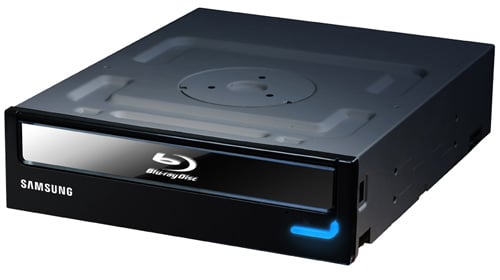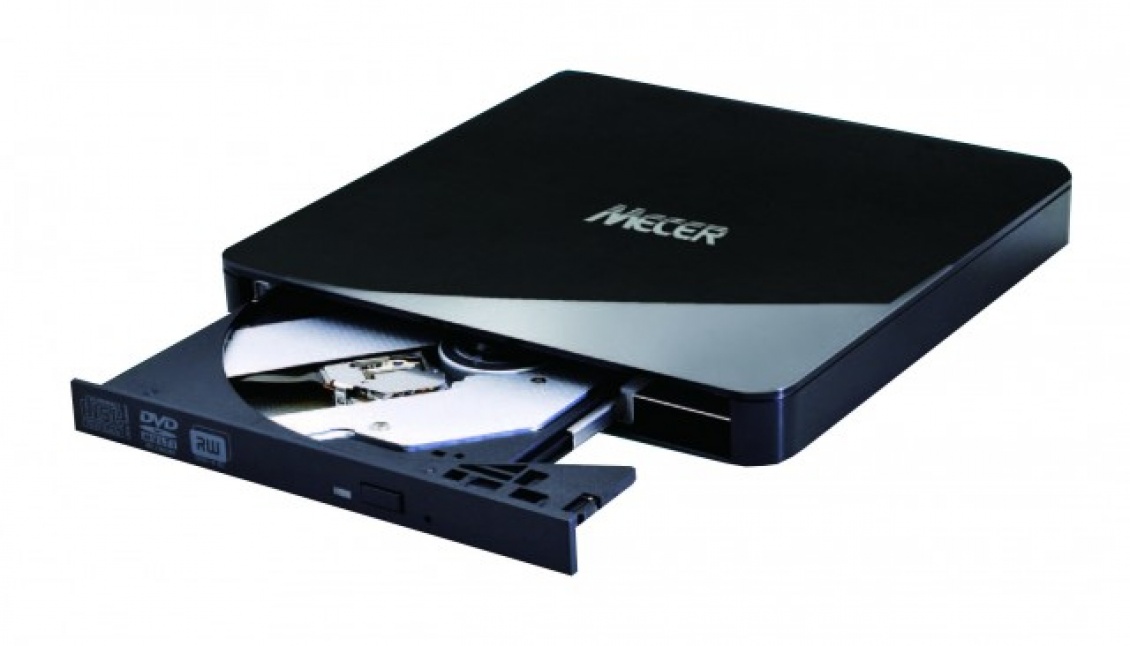Optical disc drive
As a burner optical drive is in Information Technology, denoted by which CDs, DVDs or Blu -ray discs read both as described also with burning programs ( " burned ") can be. In contrast to the reproduction in a pressing plant data is duplicated from a burner, not replicated.
- 3.1 Compact Disc
- 3.2 Digital Versatile Disc
- 3.3 Blu- ray Disc
History
First, audio CDs and CD -ROMs by end users could only read or played, but are not themselves described. In 1992 ( at Photokina ) came CD burner on the market, but these had a prohibitive price for many users ( 22,000 DM). With the launch of the DVD, the CD - burners were much cheaper and thus suitable for the mass market. Today DVD burner belong with new computers as standard. In recent years, DVD burners were installed in consumer electronics such as video recorders and hi-fi systems.
Initially, especially the increase in the reading and writing speeds of the drives was driven; now support as many different CD and DVD formats, as well as the increase in the burning quality is sought.
Since it can be reproduced with burners copyrighted material, manufacturers and importers of burners have to pay a flat-rate charge to collecting societies since the early 1990s.
Basic burner variants
Subsequently, the three basic burner variants in their historical order ( CD, DVD and BD).
CD burner
A CD burner is a device for writing to CD -R or CD -RW blanks, which can then be read by a standard CD player or CD- ROM drive. The CD writer of the first generation can only describe CD - R blanks. All today on the market CD burners can write both CD - R discs and CD- RW discs.
The CD burner works with a laser, with the material of the CD-R or CD-RW is locally heated, so that change the reflective properties. For CD- Rs, this process is irreversible, while CD - RW discs can be erased.
The speed of the Beschreibvorgangs, also called burning process, in multiples of 176.4 KB / s ( raw or music data; equivalent to 150 KB / s payload ), where this corresponds to the reading speed of a normal audio CD. So need a 4- burner to burn a 74 -minute CD ( 650 MB) 18.5 minutes. Burning speeds up to 56 -fold are common. At speeds of more than 48 -fold the risk of damaging the blanks by the centrifugal forces, which is why most commercial burners operate with up to 48 -fold or 52 -fold.
Devices which burn and read DVDs but can only read CDs - in other words, CD burners with integrated DVD drive - is called combo drives; by the fall in prices of DVD burners, these have virtually disappeared from the market. They were used primarily as increasingly slimline drive in notebooks and Intel Macs without the " superdrive ".
CD burners can usually write outside the specified ranges, such as audio CDs beyond 74 minutes, especially in the area of 80 to 82 minutes. This ability is called overburn ( " overburning "). Here, there is a risk that some CD players in this field can not be read.
CD burners that are designed exclusively for recording or duplication of audio CDs are called CD recorder.
DVD burner
A DVD burner, the development of the CD burner is a device for writing DVD media. All modern DVD writer can read CDs and DVDs described, almost all can also write to CD - blanks.
The combustion technology is similar to the CD burner, only the device operates at a higher resolution.
The speed of the burning process is given in multiples of 1,385 MiB / s. " One -way " therefore means about an hour a 4.7 GB blank (corresponding to 4.38 GiB or 4489 MiB), "2 -fold " corresponds to half an hour per disc, " 4x " is equivalent to a quarter of an hour etc.
The higher speeds (from about 6 -fold) are no longer effective on the entire blank. The burner to increase the speed from the inside to the outside in two different methods: continuous in the CAV mode or stepwise in the ZCLV mode. Thus, the effective burning rate at higher nominal rates only increases low. However, since impact material fluctuations, especially in the outer edge portions of the blank DVD discs increases with firing rate - which of course only in the outer region comes into play - the error rate.
Most DVD blanks described DVD Burner can be played in both DVD -ROM PC drives, as well as in today's DVD players. DVD - R discs are often more readable than DVD R discs, because only they are standardized. If use is made of the possibility of Bitsettings, DVD R discs are, however, accepted by some drives that repel recordable DVDs else.
Newer burners can also DL ( Double Layer and Dual Layer) describe a volume of 8.5 GB ( 8152 MiB accordingly 7.96 GiB respectively ).
The following designations are used in DVD burners:
- Multi = DVD-R/-RW and DVD R / RW
- Super = additional DVD-RAM
- Plus = additionally Double Layer
- SuperDrive can = a burner in Apple computers, the DVD and CD read and write.
A Super Multi Plus DVD burner about so is compatible with DVD ± R / RW and DVD-RAM and can also double-layered media (if available) describe.
BD burner
A BD burner is the successor of the CD and DVD burner and can next to Blu -ray discs (BD, BD -R and BD -RE) read a rule, all previous formats (including DVD-RAM) and describe. Many BD burner can also read HD - DVDs.
SuperDrive
SuperDrive is an Apple - specific drive that 1988-99 for the 3.5 " format was introduced and since 2001 designated a CD / DVD burner. The SuperDrive is called a" run slot load drive " and is therefore not in a position to mini- to process CD format.
Theoretical burning time compared
In the following tables, the focal length of the typical cartridges on the market blanks ( discs ) is compared.
Compact disc
Digital Versatile Disc
Blu- ray Disc
The firing time corresponding to the time until a blank is described fully with data. These values are derived from the data rate and the data capacity of the blank. In practice, the recording time is usually higher because the blanks are not described at high burning speed from the start with the set burning speed. The data on the blank i.d.R. written from the inside to the outside, thereby the combustion speed is slow on the inside. Furthermore, for example, for the lead-in or lead-out changed the burning speed. A data summary ( buffer underrun ) also contributes to a longer focal length.
Focal labeling techniques
Since 2004, different methods exist to label the blank directly to the burner and a suitable program. Currently, there are two different techniques, namely LightScribe and Labelflash. The predecessor of Labelflash is DiscT @ 2
Recorder Identification Code
Under pressure from the music industry ( represented by IFPI and RIAA ) has taken out a so-called Recorder Identification Code (RID ) as a measure for the unambiguous assignment of each burned CD burner to her in the Rainbow Books Philips. The RID Code is thus the counterpart to the Source Identification Code ( SID), the eight -character code corresponding to blank CDs.
The RID Code consists of the manufacturer code ( for example, " PHI " for Philips), the model number and the unique serial number of the burner.
2006 received the negative price for this Philips Big Brother Award.
Incompatibilities
In connection especially with the CD burning repeatedly occur incompatibilities that are often due to a false writing strategy in the set.
- Some CD burners can not process certain blanks.
- Especially older CD -ROM drives and audio CD players can not read or read only on certain blanks burned CDs burned CDs. Alternatively, the burned CD is recognized, but it comes to reading errors.
- Older CD -ROM drives and audio CD players can not read burned CD -RW discs.
- CD-RW discs that were burned with more than four times the normal speed, can not be read by older devices.
It is discussed in this context, whether the burning speed of CD -R has an effect on their readability in other devices.
If the burned CD is detected but it comes to reading errors, this can be due to dust in the laser unit of the affected devices.










